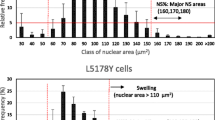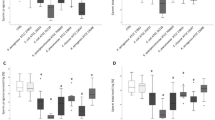Abstract
The mycotoxin ochratoxin A (OTA) and its metabolite ochratoxin alpha (OT-alpha) were investigated, to examine their potency to induce sister chromatid exchages (SCE) in cultured poricine urinary baldder epithedial cells (PUBEC) (primary cluture). Serum-free cultured PUBEC were incubated for 5 h with either OTA or OT-alpha, respectively, and subsequently cutured in the presence of 5-bromo-2-deoxyuridine (BrdU). After two cell cycles, mitosis was inhibited by the colchicine derivative Colcemid, cells were fixed and chromosomes were prepared for SCE analysis. For OTA, a dose-dependent increase in SCE frequency was measured in concentrations between 100 pM and 100 nM OTA. At 100nM OTA, SCE frequency increased by about 41%, compared to the base SCE level (7.27 SCEs per chromosome set, solvent control). Higher concentrations of OTA were cytotoxic. The metabolite OT-alpha also increased SCE frequency, but at higher concentrations. At a concentration of 10μM OT-alpha, an increase of about 55% was detected. OT-alpha showed no cytotoxic effect. There results indicate that OTA is genotoxic in this in vitro system, which represents the urinary bladder epithelium, a target organ of OTA in vivo. It could also be shown that OT-alpha, which is said to be non-toxic, is genotoxic in this assay at higher concentrations.
Similar content being viewed by others
References
Bach PH, Bartsch H (1993) Fungal toxins and health. Trends Pharmacol Sci 14: 424–426
Bartsch H, Malaveille C, Camus AM, Martel-Planche G, Brun G, Hautelfeville A, Sabadie N, Barbin A, Kuoki T, Drevon C, Piccoli A, Montesano R (1980) Validation and comparative studies on 180 chemicals with S. typhimurium strains and V79 Chinese hamster cells in the presence of various metabolizing systems. Mutat Res 76: 1–50
Bendele AM, Neal SB, Oberly TJ, Thompson CZ, Bewsey BJ, Hill LE, Rexroat MA, Carlton WW, Probst GS (1985) Evaluation of ochratoxin A for mutagenicity in a battery of bacterial and mammalian cell assays. Food Chem Toxicol 23: 911–918.
Bunge I, Dirheimer G, Röschenthaler R (1978) In vivo and in vitro inhibition of protein synthesis in Bacillus stearothermophilus by ochratioxin A. Biochem Biophys Res Commun 83: 398–405
Carrano AV, Natarajan AT (1988) Consideration for population monitoring using cytogenetic techniques. Mutat Res 204: 379–406
Carrano AV, Thompson LH (1981) Sister chromatid exchange and gene mutation. Cytogenet Cell Gent 33: 57–61
Castegnaro M, Chernozemsky IN, Hietanen E, Bartsch H (1990) Are mycotoxins risk factors for endemic nephropathy and associated urothelial cancers?. Arch Geschwulstforsch 60: 295–303
Cleaver JE (1981) Correlations between sister chromatid exchange frequenceis and replicon sizes. A model for the mechanism of SCE production. Exp Cell Res 136: 27–30
Cooray R (1984) Effects of some mycotoxins on mitogen-induced blastogenesis and SCE frequency in human lymphocytes. Food Chem Toxicol 22: 529–534
Creppy EE, Lugnier AAJ Fasiolo F, Heller K, Röschenthaler R, Dirheimer G (1979a) In vitro inhibition of yeast phenylalanine-tRNA synthetase by ochratoxin A. Chem Biol Interact 24: 257–262
Creppy EE, Schlegel M, Röschenthaler R, Dirheimer G (1979b) Phenylalanine prevents acute poisoning by ochratoxin A in mice. Toxicol Lett 6: 77–80
Creppy EE, Størmer F, Kern D, Röschenthaler R, Dirheimer G (1983a) Effects of ochratoxin A metabolites on yeast phenylalanyl-tRNA synthetase and on the growth and in vivo protein synthesis of hepatoma cells. Chem Biol Interact 47: 239–247
Creppy EE, Kern D, Steyn PS, Vlegaar R, Röschenthaler R, Dirheimer G (1983b) Comparative study of the effect of ochratoxin analogues pn yeast aminoacyl-tRNA synthetases and on the growth and protein synthesis of hepatoma cells. Toxicol Lett 19: 217–224
Creppy EE, Kane A, Dirheimer G, Lafarge-Frayssinet C, Mousset S, Frayssinet D (1985) Genotoxicity of ochratoxin A in mice: DNA signle-strand break evaluation in spleen, liver, and kidney. Toxicol Lett 28: 29–35
Creppy EE, Chakor K, Fischer MJ, Dirheimer G (1990) The mycotoxin ochratoxin A is a substrate for phenylalanine hydrolase in isolated rat hepatocytes and in vivo. Arch Toxicol 64: 279–284
Dirheimer G, Creppy EE (1991) Mechnism of action of ochratoxin A. In: Castegnaro M, Plestina R, Dirheimer G, Chernozemsky IN, Bartsch H (eds) Mycotoxins, endemic nephropathy and urinary tract tumours. IARC, Lyon, pp 171–186
Galtier P (1991) Pharmacokinetics of ochratoxin A in animals. In: Bartsch H (eds) Mycotoxins, endemic nephropathy and urinary tract tumours. IARC, Lyon, pp 187–200
Guhe C, Föllmann W (1994) Growth and characterization of porcine urinary bladder epithelial cells in vitro. Am J Physiol 266: F298-F308
Hadidane R, Bacha H, Creppy EE, Hammami M, Ellouze E, Dirheimer G (1992) Isolation and structure determination of natural analogues of the mycotoxin ochratoxin A produced by Aspergillus ochraceus. Toxicology 76: 233–243
Hald B (1991) Porcine nephropathy in Europe. In: Castegnaro M, Plestina R, Dirheimer G, Chernozemsky IN, Bartsch H (eds) Mycotoxins, endemic nephropathy and urinary tract tumours. IARC, Lyon, pp 49–56
Haubeck HD, Lorkowski G, Kölsch E, Röschenthaler R (1981) Immunosuppression by ochratoxin A and its prevention by phenylalanine. Appl Environ Microbiol 41: 1040–1042
Henning A, Fink-Gremmels J, Leistner L (1991) Mutagenicity and effects of ochratoxin A on the frequency of sister chromatid exchange after metabolic activation. In: Castegnaro M, Plestina R, Dirheimer G, Chernozemsky IN Bartsch H (eds) Mycotoxins, endemic nephropathy and urinary tract tumours. IARC, Lyon, pp 255–260
Kane A (1986) Intoxication subchronique par lóchratoxine A, mycotoxine contaminant les ailments: effets nephrotoxiques et genotoxiques. These Universite Louis Pasteur, Strasbourg
Kane A, Creppy EE, Röschenthaler R, Dirheimer G (1986a) Changes in urinary and renal tubular enzymes caused by subchronic administration of ochratoxin A in rats. Toxicology 42: 233–243
Kane A, Creppy EE, Roth A, Röschenthaler R, Dirheimer G (1986b) Distribution of the (3H)-label from low doses of radioactive ochratoxin A ingested by rats, and evidence for DNA singlestrand breaks caused in liver and kidneys. Arch Toxicol 58: 219–224
Krogh P, Hald B, Pedersen EJ (1973) Occurrence of ochratoxin A and citrinin in cereals associated with mycotoxic procine nephropathy. Acta Pathol Microbiol Scand B 81: 689–695
Kuczuk MH, Benson PM, Health H, Hayes AW (1978) Evaluation of the mutagenic potential of mycotoxins using Salmonella typhimurium and Saccharomyces cerevisiae. Mutat Res 53: 11–20
Kuiper-Goodman T (1991) Risk assessment of ochratoxin A residues in food. In: Castegnaro M, Plestina P, Dirheimer G, Chernozemsky IN, Bartsch H (eds) Mycotoxins, endemic nephropathy and urinary tract tumours. IARC, Lyon, pp 307–320
Kuiper-Goodman T, Scott PM (1989) Risk assessment of the mycotoxin ochratoxin A. Biomed Environ Sci 2: 179–248
Malaveille C, Brun G, Bartsch H (1991) Genotoxicity of ochratoxin A and structurally related compounds in Escherichia coli strains: studies on their mode of action. In: Castegnaro M, Plestina R, Dirheimer G, Chernozemsky IN, Bartsch H (eds) Mycotoxins, endemic nephropathy and urinary tract tumours. IARC, Lyon. pp 261–266
Mayura K, Parker R, Berndt WO, Philips TD (1984) Ochratoxin A induced teratogenesis in rats: partial protection by phenylalanine. Appl Environ Microbiol 48: 1186–1188
Mori H, Kawai K, Ohbayashi F, Kuniyasu T, Yamazaki M, Hamasaki T, Williams GM (1984) Genotoxicity of a variety of mycotoxins in the hepatocyte primary culture/DNA repair test using rat and mouse hepatocytes. Cancer Res 44: 2918–2923
NTP (1989) NTP Technical Report on Tocicology and Carcinogenesis Studies of Ochratoxin A (CAS NO. 303-47-9) in F344/N Rats (Gavage Studies) Boorman G, ed.) NIH Publication No. 89–2813. US Department of Health and Human Services, National Institute of Health, Research Triangle Park, N.C.
Olsen JH, Hald B, Thorup I, Carstensen B (1993) Distribution in Denmark of procine nephropathy and chronic disorders of the urinary tract in humans. In: Creppy EE, Castegnaro M, Dirheimer G (eds) Human ochratoxicosis and its pathologies.
Omar RF, Hasinoff BB, Mejilla F, Rahimtula AD (1990) Mechanism of ochratoxin A stimulated lipid peroxidation. Biochem Pharmacol 40: 1183–1191
Petkova-Bocharova T, Castegnaro M (1991) Ochratoxin A in human blood in relation to Balkan endemic nephropathy and urinary tract tumours in Bulgaria. In: Castegnaro M, Plestina R, Dirheimer G, Chernozemsky IN, Bartsch H (eds) Mycotoxins, endemic nephropathy and urinary tract tumours, IARC, Lyon, pp 135–137
Pfohl-Leszkowicz A, Grosse Y, Kane A, Creppy EE, Dirheimet G (1993) Differential DNA-adduct formation and disappearance in three mouse tissues after treatment with the mycotoxin ochratoxin A. Mutat Res 289: 265–273
Pohland AE, Nesheim S, Friedmann L (1992) Ochratoxin A: a review. Pure Appl Chem 64: 1029–1046
Rahimtula AD, Bereziat JC, Bussacchini-Giriot V, Bartsch H (1988) Lipid peroxidation as possible cause of ochratoxin A toxicity. Biochem Pharmacol 37: 4469–4477
Shafer DA (1982) Alternate replication bypass mechanisms for sister chromatid exchange formation. Prog Topics Cytogenet 2: 67–98
Speijers GJA, Van Egmond HP (1993) Worldwide ochratoxin A levels in food and feeds. In: Creppy EE, Castegnaro M, Dirheimer G (eds) Human ochratoxicosis and its pathologies. Colloque INSERM/John Libbey Eurotext, vol. 231, pp 85–100
Stetina R, Votava M (1986) Induction of DNA single-strand breaks and DNA synthesis inhibition by patulin, ochratoxin A, citrinin, and aflatoxin B1 in cell lines CHO and AWRF. Folia Biol 32: 128–144
Steyn PS (1993) Mycotoxins of human health concenrn. In: Creppy EE, Castegnaro M, Dirheimer G (eds) Human ochratoxicosis and its pathologies. Colloque INSERM/John Libbey Eurotext, vol. 231, pp 3–31
Umeda M, Tsutsui T, Saito M (1977) Mutagenicity and inducibility of DNA single-strand breaks and chromosome aberrations by various mycotoxins. Gann 68: 619–625
Van der Merwe KJ, Steyn PS, Fourie L, Scott DB, Theron JJ (1965) Ochratoxin A, a toxic metabolite produced by Aspergillus ochraceus Wilh. Nature 205: 1112–1113
Wolff S, Bodycote J, Painter RB (1974) Sister chromatid exchanges induced in Chinese hamster cells by UV irradiation in different stages of the cell cycle: the necessity for cells pass through S. Mutat Res 25: 73–81
Author information
Authors and Affiliations
Rights and permissions
About this article
Cite this article
Föllmann, W., Hillebrand, I.E., Creppy, E.E. et al. Sister chromatid exchange frequency in cultured isolated porcine urinary bladder epithelial cells (PUBEC) treated with ochratoxin A and alpha. Arch Toxicol 69, 280–286 (1995). https://doi.org/10.1007/s002040050171
Received:
Accepted:
Issue Date:
DOI: https://doi.org/10.1007/s002040050171




